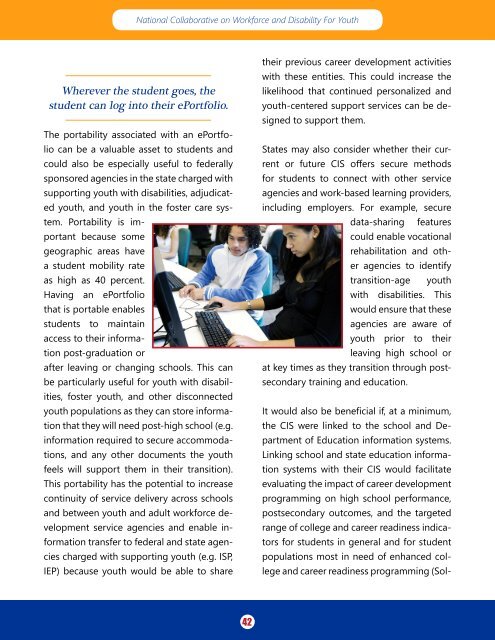Designing Statewide Strategies & Programs
DesigningStatewideCareerDevelopmentStrategiesProgramsPub_0
DesigningStatewideCareerDevelopmentStrategiesProgramsPub_0
Create successful ePaper yourself
Turn your PDF publications into a flip-book with our unique Google optimized e-Paper software.
National Collaborative on Workforce and Disability For Youth<br />
Wherever the student goes, the<br />
student can log into their ePortfolio.<br />
The portability associated with an ePortfolio<br />
can be a valuable asset to students and<br />
could also be especially useful to federally<br />
sponsored agencies in the state charged with<br />
supporting youth with disabilities, adjudicated<br />
youth, and youth in the foster care system.<br />
Portability is important<br />
because some<br />
geographic areas have<br />
a student mobility rate<br />
as high as 40 percent.<br />
Having an ePortfolio<br />
that is portable enables<br />
students to maintain<br />
access to their information<br />
post-graduation or<br />
after leaving or changing schools. This can<br />
be particularly useful for youth with disabilities,<br />
foster youth, and other disconnected<br />
youth populations as they can store information<br />
that they will need post-high school (e.g.<br />
information required to secure accommodations,<br />
and any other documents the youth<br />
feels will support them in their transition).<br />
This portability has the potential to increase<br />
continuity of service delivery across schools<br />
and between youth and adult workforce development<br />
service agencies and enable information<br />
transfer to federal and state agencies<br />
charged with supporting youth (e.g. ISP,<br />
IEP) because youth would be able to share<br />
their previous career development activities<br />
with these entities. This could increase the<br />
likelihood that continued personalized and<br />
youth-centered support services can be designed<br />
to support them.<br />
States may also consider whether their current<br />
or future CIS offers secure methods<br />
for students to connect with other service<br />
agencies and work-based learning providers,<br />
including employers. For example, secure<br />
data-sharing features<br />
could enable vocational<br />
rehabilitation and other<br />
agencies to identify<br />
transition-age youth<br />
with disabilities. This<br />
would ensure that these<br />
agencies are aware of<br />
youth prior to their<br />
leaving high school or<br />
at key times as they transition through postsecondary<br />
training and education.<br />
It would also be beneficial if, at a minimum,<br />
the CIS were linked to the school and Department<br />
of Education information systems.<br />
Linking school and state education information<br />
systems with their CIS would facilitate<br />
evaluating the impact of career development<br />
programming on high school performance,<br />
postsecondary outcomes, and the targeted<br />
range of college and career readiness indicators<br />
for students in general and for student<br />
populations most in need of enhanced college<br />
and career readiness programming (Sol-<br />
42


